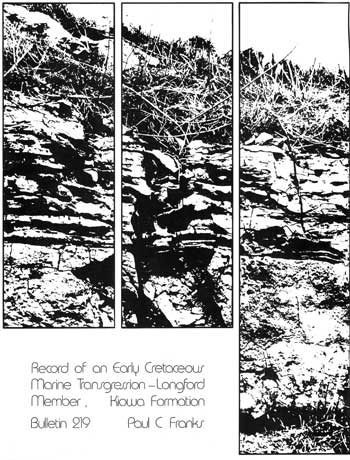Longford Member, Kiowa Formation, North-Central Kansas: Paralic to Fluvial Record of an Early Cretaceous Marine Transgression
DOI:
https://doi.org/10.17161/kgsbulletin.no.i219.22269Abstract
A distinctive facies of the Albian Kiowa Formation is exposed along the eastern fringes of the Kiowa outcrop belt in north-central Kansas. The name "Longford Member of the Kiowa Formation" is proposed for the distinctive unit, which is as much as 100 ft (30 m) thick. Conspicuous, nearly white siltstone as much as 15 ft (4.6 m) thick, marks the top of the member. The lower parts of the member consist of clay rocks, siltstone, sandstone, and lignite. Red-mottled clay rocks, red-mottled siltstone, and the nearly white siltstone at the top of the member form a striking contrast to drab shale and yellowish-gray to brown sandstone in other parts of the Kiowa Formation. The Longford Member rests with transgressive disconformity on Lower Permian rocks. Along most of the outcrop belt, it is overlain conformably by higher parts of the Kiowa Formation. About 30 mi (48 km) south of the Kansas-Nebraska border, near the northward pinchout of the Kiowa Formation, the member is overlain by the Dakota Formation (Albian? and Cenomanian). The siltstone at the top of the Longford Member is the northernmost Kiowa rock that can be identified with certainty as the formation pinches out.
Longford sediments were deposited as the Kiowa sea transgressed onto the eroded, gently dipping, western flank of the Nemaha anticline. Kiowa barrier-bar systems and the topography developed on Permian bedrock influenced both the thickness and the depositional environments of the Longford Member. The siltstone that marks the top of the unit stems from sedimentation along the landward, inner shores of lagoons or bays that formed behind Kiowa barrier bars. Sedimentary structures and fossil reeds and rootlets suggest that the inner shores were affected by tides.
The lower parts of the Longford Member formed from sediments that accumulated in fluvial and estuarine realms that developed in broad valleys eroded into Permian bedrock. Log-probability plots of grain-size distributions support a fluvial origin for most Longford sandstone. Red-mottled, kaolinitic and smectitic clay rocks and scarce red-mottled siltstone represent floodplain deposits. The red mottling accords with gleying in immature, tropical soils. A pedogenic origin for the red-mottled clay rocks also is indicated by plexoidal and domain clay fabrics similar to those common in soils, and by "clay skins" around detrital quartz grains. Lenses of dark, smectitic claystone may be fossil vertisols that developed in floodbasins or on estuarine bayhead deltas. Lignite seams and lenses represent floodbasin deposits, but some of them may have formed from detrital accumulations of plant debris on estuarine delta plains. Sequences of light-gray siltstone may also represent estuarine sediments.
Light-gray, smectitic, commonly silty Kiowa shale overlying the Longford Member probably formed from lagoon or bay sediments. Kiowa rocks above the lagoon or bay deposits indicate that transgression was accompanied by in-place growth and eventual submergence of Kiowa barrier systems. Submergence resulted in landward shifting of surf zones and in construction of new barriers near the former inner shores of lagoons or bays. Open-sea, illitic, Kiowa shale overlies the lagoon or bay deposits in many places. Shoreface erosion, or other processes of ravinement, did not lead to the development of either marked or extensive disconformities during transgression. Instead, remarkably complete transgressive records of fluvial, estuarine, lagoon, and bay sedimentation were preserved.
Fossil soils along the Permian-Cretaceous unconformity in central Kansas indicate that the kaolinite and smectite in Longford clay rocks were reworked from similar soils developed on Paleozoic source rocks in the continental interior. Clay-mineral assemblages in facies-equivalent Longford and Kiowa rocks accord with, but do not prove, derivation of the abundant illite in Kiowa shale from sources that were different from those that supplied kaolinite and smectite to Longford depositional systems. Longford sandstone was derived mainly from Paleozoic terrains in the continental interior, but staurolite grains in the sandstone suggest that some of the sand ultimately came from the crystalline terrains of the central Appalachian Mountains.
Downloads

